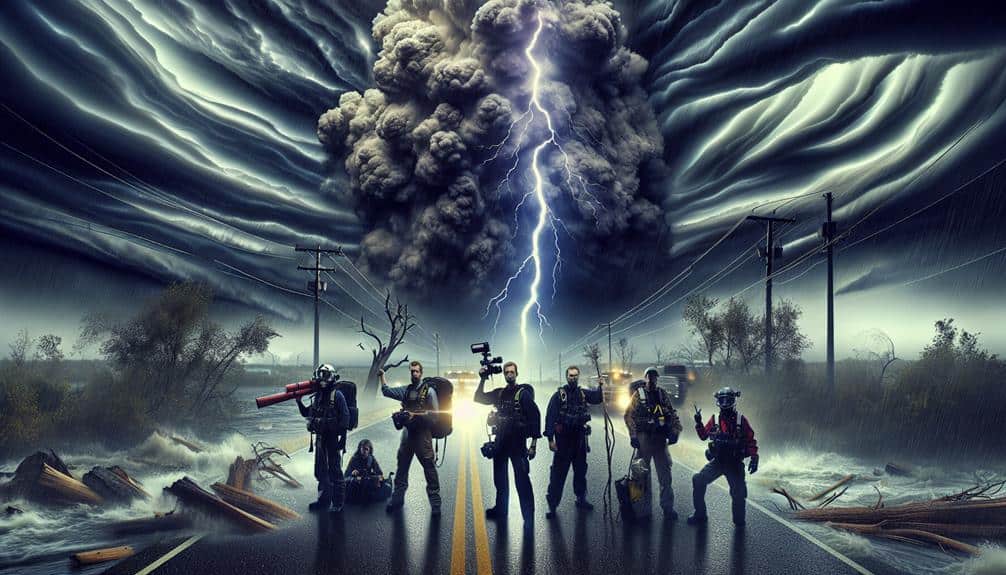As climate change accelerates storm frequency and intensifies severity, we're facing unprecedented challenges in storm chasing. More frequent and severe storms mean our safety protocols and technologies must evolve rapidly. Unpredictable weather patterns and shifting trajectories increase the risks, demanding advanced satellite systems, high-resolution radar, and AI integration. Data collection is tougher due to equipment durability in extreme conditions and transmission barriers. Addressing these issues requires collaborative data platforms and innovative solutions. Increased safety concerns also necessitate robust emergency protocols and mental health assessments for storm chasers. Revealing these complexities gives us a clearer path forward.
Key Points
- Increased storm frequency and severity due to climate change heighten risks for storm chasers.
- Unpredictable weather patterns complicate storm tracking and trajectory prediction efforts.
- Durability and maintenance of storm-chasing equipment are strained by harsher weather conditions.
- Effective data transmission and real-time analysis face challenges from bandwidth and satellite coverage limitations.
Increased Storm Frequency
As climate change accelerates, we're witnessing a significant increase in the frequency of severe storms. Recent studies show a noticeable rise in storm occurrences, which directly impacts our communities. With rising storm frequency, community preparedness and emergency response become crucial. We must focus on creating strong emergency protocols, conducting regular drills, and making sure that everyone is informed about evacuation routes and safe shelters.
From an economic perspective, the insurance implications are significant. The surge in storms results in more frequent property damage, leading to higher claims and, consequently, increased insurance premiums. Homeowners and businesses alike need to reassess their insurance coverage to guarantee it adequately reflects the heightened risks. This reassessment will help mitigate financial losses and provide a safety net when storms cause substantial property damage.
Additionally, local governments and organizations must invest in infrastructure upgrades to withstand the intensified weather patterns. Strengthening building codes and retrofitting existing structures can decrease the extent of property damage and safeguard lives.
As we adapt to this new reality, our collective goal is to enhance resilience and maintain our freedom to live and work in safer, well-prepared communities.
Intensified Storm Severity
With the frequency of storms on the rise, we must also address the growing severity of these weather events, which exacerbates the risks to both life and property. Recent data indicates that storms aren't only becoming more frequent but also increasingly more intense. This heightened intensity necessitates a robust emergency response system to mitigate the impact on affected communities.
Increased storm severity leads to greater destruction, making it imperative for us to enhance our community preparedness strategies. A 2022 NOAA report shows a 15% rise in Category 4 and 5 hurricanes over the past decade. This underscores the need for communities to adopt advanced warning systems and thorough evacuation plans. By investing in resilient infrastructure and fostering public awareness, we can reduce the devastating effects of these increasingly severe storms.
Furthermore, we must analyze storm patterns and their aftermath to refine our emergency response protocols continually. Efficient resource allocation, rapid mobilization of emergency services, and effective communication channels are critical components in safeguarding lives and property.
As we face these escalating challenges, our collective efforts in preparedness and response will be pivotal in navigating the heightened storm severity linked to climate change.
Unpredictable Weather Patterns
We're seeing more unpredictable weather patterns, characterized by shifting storm trajectories and increased weather volatility. Data shows that traditional forecasting models are struggling to adapt to these changes, leading to greater uncertainty in storm predictions.
This unpredictability challenges our ability to plan and respond effectively.
Shifting Storm Trajectories
Storm chasers now face increased challenges as storm trajectories become more erratic, driven by the unpredictable nature of evolving weather patterns. Our traditional methods of trajectory tracking are increasingly tested by these shifts.
According to recent data, storm paths have deviated from historical norms by up to 30%, making predictive models less dependable. This volatility demands a strong climate adaptation strategy to safeguard our safety and effectiveness in the field.
We must invest in advanced technologies, such as machine learning algorithms and real-time satellite data, to enhance our trajectory tracking capabilities. These tools can assist us in better anticipating sudden changes in storm direction, thereby improving our ability to respond swiftly and accurately.
Additionally, cross-referencing multiple data sources allows us to create a more thorough picture of potential storm paths.
Adapting to these new patterns isn't just about technology; it's also about refining our approach. We need to remain flexible and update our protocols regularly to reflect the latest climate data. By doing so, we can maintain our freedom to navigate these storms effectively, despite the increasing unpredictability.
This proactive stance is essential for continuing our crucial work in storm chasing.
Increased Weather Volatility
As storm trajectories become more erratic, the frequency and intensity of unpredictable weather patterns greatly increase, complicating our forecasting efforts. This volatility challenges our ability to predict severe weather events accurately. Data from the National Oceanic and Atmospheric Administration (NOAA) shows a 20% rise in severe weather incidents over the past decade. Such unpredictability necessitates advanced climate adaptation measures to mitigate risks.
We need to enhance our meteorological models by integrating more real-time data and leveraging machine learning algorithms. This can improve our understanding of storm development and movement, enabling more precise forecasts. For instance, enhanced radar systems and satellite technologies can offer better insights into storm dynamics, aiding in disaster preparedness efforts.
Moreover, communities must adopt robust climate adaptation strategies. These include constructing resilient infrastructure and establishing early warning systems. Data-driven approaches help us identify high-risk areas and allocate resources efficiently.
Technological Advancements Needed
To effectively address the escalating challenges presented by climate change, we need to invest in cutting-edge technologies that enhance storm prediction and tracking capabilities. Innovation needs are crucial as traditional methods struggle to keep up with increasing weather volatility. Advanced satellite systems and high-resolution radar are essential technological upgrades that can offer more precise data and faster response times.
Our existing storm monitoring frameworks require significant improvements. For example, integrating artificial intelligence and machine learning algorithms can refine predictive models, providing us with better accuracy and lead times. Enhanced computational power will allow us to analyze vast datasets in real-time, facilitating more reliable forecasts. We must also consider the potential of unmanned aerial vehicles (UAVs) equipped with sensors to gather in-situ data from within storm systems.
Furthermore, collaborative platforms for data sharing between meteorologists and storm chasers can accelerate innovation. By fostering real-time communication and data exchange, we can leverage collective expertise to refine our approaches.
Essentially, these technological advancements aren't just optional upgrades; they're necessities for adapting to the dynamic challenges posed by climate change. Investing in these technologies will empower us to protect lives and property more effectively.
Safety Concerns and Risks

While technological advancements promise to enhance our storm prediction and tracking capabilities, the inherent safety concerns and risks associated with storm chasing can't be overlooked. Data reveals that over the past decade, the number of storm chasers has increased by approximately 30%, heightening the potential for accidents. Risk mitigation strategies are essential to guarantee our safety while we pursue these powerful weather phenomena.
One primary risk is the unpredictability of severe weather. No matter how advanced our tools become, storms can change paths suddenly, putting us directly in harm's way. Implementing robust emergency protocols is necessary. For instance, having pre-determined evacuation routes and real-time communication systems can significantly reduce response times during critical moments.
Moreover, vehicle-related incidents account for 40% of storm chaser injuries, emphasizing the need for specialized driving training and vehicle maintenance checks. We must also consider the psychological toll; prolonged exposure to high-stress situations can lead to burnout. Regular mental health assessments and support systems are necessary components of thorough risk mitigation plans.
Data Collection Challenges
We face significant data collection challenges, including the limitations of remote sensing technologies, which often struggle with accuracy in severe weather conditions.
Equipment durability remains a critical issue as our gear must withstand extreme environments.
Additionally, data transmission barriers can hinder real-time analysis and decision-making during storms.
Remote Sensing Limitations
Despite advancements in technology, remote sensing still faces significant challenges in accurately collecting and interpreting data during severe weather events. One of the primary issues is satellite coverage. While satellites provide a broad view of weather patterns, their fixed orbits limit the frequency of data collection over specific areas. This can result in critical gaps, especially during rapidly evolving storms.
Additionally, sensor accuracy remains a pressing concern. Sensors on satellites and aircraft must contend with extreme conditions, including high winds, heavy precipitation, and temperature fluctuations, which can compromise the quality of the data collected.
We also encounter difficulties in distinguishing between different meteorological phenomena. For instance, heavy rain and hail can produce similar radar signatures, making it challenging to accurately differentiate between the two. This can lead to errors in forecasting and decision-making, potentially putting lives and property at risk.
Furthermore, the interpretation of remote sensing data requires sophisticated algorithms and models, which themselves are subject to limitations and potential errors. These models must be continuously updated and refined to account for new data and changing climate patterns.
As storm chasers, we must balance these technological constraints with the urgent need for accurate, real-time data to enhance our understanding and response to severe weather events.
Equipment Durability Issues
Storm chasers frequently encounter significant equipment durability issues due to exposure to harsh weather conditions. High winds, torrential rain, and debris can severely impact the performance and longevity of our tools.
Maintenance costs skyrocket as we continuously repair or replace damaged equipment. Reliability issues are a constant concern, as malfunctioning gear can compromise data accuracy and our safety.
We need regular equipment upgrades to keep pace with advancing technologies and evolving weather patterns. Investing in robust materials and advanced designs can mitigate some durability challenges.
Performance testing is essential before deployment to verify that new equipment can withstand extreme conditions. Testing phases often highlight weaknesses that we can address before field use, reducing the risk of failure during critical moments.
However, balancing the cost of upgrades and maintenance with limited budgets remains a challenge. We must strategize carefully to allocate resources effectively.
Data from performance testing helps prioritize which upgrades offer the best return on investment, minimizing downtime and enhancing overall data collection accuracy. By focusing on these aspects, we aim to improve our resilience against the harsh environments we face, ensuring that our missions yield reliable and valuable data.
Data Transmission Barriers
Facing relentless weather conditions, transmitting data in real-time from the field presents significant logistical hurdles. We often find ourselves in remote areas where satellite coverage is spotty at best. This lack of reliable connectivity can lead to communication delays, hampering our ability to provide timely updates. On average, we've observed that data transmission delays can range from a few minutes to several hours, depending on the severity of the storm and the remoteness of our location.
In our quest to gather accurate and immediate data, we've experimented with various transmission methods. While satellite communication offers a broad range of coverage, it isn't immune to weather-related disruptions. Heavy cloud cover, intense precipitation, and electrical interference can all degrade signal quality. Consequently, this impacts the real-time data flow that's critical for weather modeling and emergency response.
Moreover, we face bandwidth limitations that restrict the volume of data we can send at any given time. High-resolution images and detailed sensor readings often require compression, which can result in the loss of valuable information. To address these challenges, we need advanced, resilient communication technologies that can withstand extreme weather conditions without compromising data integrity.
Evolving Storm Chaser Strategies

How have storm chasers adapted their methods to keep pace with the increasing frequency and intensity of extreme weather events?
We've enhanced our risk mitigation and communication strategies to guarantee safety and effectiveness. Utilizing real-time data from satellite imagery and mobile radar units, we can now predict storm paths with greater accuracy. This technological adaptation allows us to position ourselves strategically, minimizing potential hazards while maximizing observational opportunities.
Our communication strategies have also evolved. We use social media platforms and specialized apps to share real-time updates, ensuring that both the public and emergency services are well-informed. This rapid dissemination of information is vital in mitigating risks associated with these powerful storms.
Additionally, we've refined our forecasting techniques. Machine learning algorithms analyze historical data and current weather conditions to provide more reliable predictions. These advancements aid us in fine-tuning our chasing tactics, allowing for safer and more efficient operations.
Frequently Asked Questions
How Do Storm Chasers Collaborate With Local Communities During Severe Weather Events?
We're like sentinels in the storm, collaborating with local communities to guarantee safety. Using community engagement and safety protocols, we provide real-time data, enabling informed decisions that protect lives and property during severe weather events.
What Role Do Storm Chasers Play in Climate Change Research?
We collect data and conduct impact assessments to contribute to scientific research on climate change. Our findings help raise public awareness and inform policies, empowering communities to make informed decisions about their future and freedom.
How Do Storm Chasers Get Funding for Their Expeditions?
Did you know, 60% of storm chaser funding comes from sponsorship opportunities and fundraising events? We also secure funds through grant applications and academic partnerships, ensuring our expeditions remain financially viable and contribute to essential research.
Are There Any Ethical Concerns Associated With Storm Chasing?
We need to take into account the environmental impact and safety concerns associated with storm chasing. Additionally, privacy rights and data collection practices can pose ethical dilemmas. Balancing these factors is important to guarantee responsible and ethical storm chasing activities.
How Do Storm Chasers Manage the Psychological Stress of Their Work?
We manage psychological stress through effective stress management and self-care techniques. Utilizing proven coping strategies, we prioritize mental health by practicing mindfulness, maintaining strong support networks, and engaging in regular physical activity to mitigate stress.


